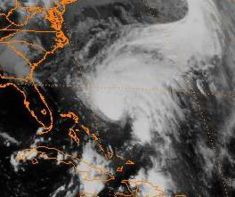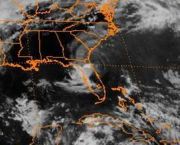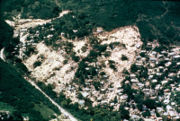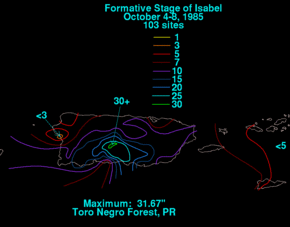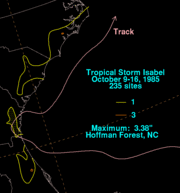Tropical Storm Isabel (1985)
2007 Schools Wikipedia Selection. Related subjects: Storms
| Tropical storm ( SSHS) | ||
|---|---|---|
|
Tropical Storm Isabel north of the Bahamas |
||
| Formed | October 7, 1985 | |
| Dissipated | October 15, 1985 | |
| Highest winds |
|
|
| Lowest pressure | 997 mbar ( hPa) | |
| Damage | $447 million (1985 USD) $793 million (2005 USD) |
|
| Fatalities | 180+ direct | |
| Areas affected |
Puerto Rico, Dominican Republic, Haiti, Florida, Georgia, South Carolina | |
| Part of the 1985 Atlantic hurricane season |
||
Tropical Storm Isabel was the ninth tropical storm of the 1985 Atlantic hurricane season. The storm's track extended from the Caribbean Sea to the southeastern United States during the second week of October. Prior to developing into a tropical cyclone, it produced torrential rainfall, resulting in great damage and loss of life in Puerto Rico. Isabel later made landfall in northeastern Florida, and moved out to sea without producing great damage.
Storm history
A tropical wave moved off the coast of Africa on September 29. As it moved westward across the Atlantic Ocean, the wave entered the eastern Caribbean Sea on October 5. On October 7, an area of disturbed weather on the northern edges of the wave organized into a tropical depression while south of Hispaniola. Shortly after forming, the depression attained tropical storm status and received the name of Isabel, although further intensification was limited by interaction with the lands of the Dominican Republic.
Located on the western edge of a mid-Atlantic high pressure system, Isabel moved northward over the Dominican Republic, and on the night of October 7, it moved northward through the southeastern Bahamas. Located over open waters, the storm quickly strengthened, and its winds reached a peak of 70 mph (110 km/h) late on the 8th, while to the northeast of the Bahamas. An approaching cold front quickly weakened the storm, and a high pressure system behind the front pushed a weakened Isabel to the west-northwest and towards land.
Convection steadily waned as it moved west-northwestward, and Isabel made landfall near Fernandina Beach, Florida as a 40 mph (65 km/h) tropical storm late on October 10. It quickly weakened to a tropical depression, and Isabel remained near the Georgia coastline until exiting near Savannah late on the 11th. The depression drifted to the northeast, and Isabel remained a minimal tropical depression until being absorbed by a frontal trough on October 15 to the east of the Outer Banks.
Impact
Heavy rainfall caused great damage and loss of life in Puerto Rico as a tropical wave. When it hit Florida, damage was very minor due to its disorganization. Overall, the storm caused over $459 million in damage (1985 USD, $815 million 2005 USD) and at least 180 deaths.
Puerto Rico
An upper level trough to the west of the precursor tropical wave enhanced rainshower activity across the northeastern Caribbean Sea. Because of this, portions of Puerto Rico experienced rainfall totals of 22 inches (560 mm) in 24 hours, while some areas received around 2.8 inches (70 mm) per hour. In the south-centre portion of the island, rainfall peaked at 31.67 inches (805 mm). This deluge of rain came five months after another rainfall event, and resulted in widespread mudslides across the island.
One such landslide occurred in Mameyes, a barrio on the southern portion of the island in Ponce. An entire sheet of bedrock in the mountainous region outside of the city collapsed under the oversaturated soil, burying much of the city. The landslide was responsible for at least 129 deaths, and caused severe damage in the area. More than 100 homes were destroyed, and many others were later condemned. The mudslide, which by some estimates could have killed up to 300 people, was among the worst landslide disasters in North American history.
Elsewhere on the island, at least 51 more people were killed from Isabel, though an exact total is unknown. The rainfall seriously damaged 8 bridges and 36 roads, and destroyed the approach slabs on one bridge in Coamo, killing eight people when they drove their cars through the opening. Thirteen individuals perished in the El Tuque portion of Ponce when a wall collapsed and flooded the area. In Santa Isabel, nineteen bodies were retrieved from the Paso Seco River, which was close to overflowing. Also in town, another bridge was deestroyed. The flooding also left 60 cities without power and 35,000 people without telephone service. Across the island, the storm damaged nearly 3,000 homes, leaving 4,400 homeless to be housed in 44 public shelters. Eleven water-filtration plants and 13 sewage treatment plants were closed following the storm, leaving 21% of the island without drinkable water. In all, the storm caused around $447 million (1985 USD, $793 million 2005 USD) in damage.
Conspiracy theory
According to a conspiracy theory on the island, an explosion in a fireworks factory led to the mudslide disaster in Mameyes. This is supported by a report that rescue dogs detected gunpowder in the area, as well as people experiencing a blast when the mudslide occurred. However, this news was supposedly kept quiet so the citizens could receive aid from FEMA.
Southeast United States
When Isabel made landfall on northeastern Florida, the storm retained little convection. It dropped light rain along the southeastern United States coastline, peaking at 3.38 inches in southeastern North Carolina. Overall, damage was relatively light.
Aftermath
Just days after the storm, the United States House of Representatives passed a resolution to provide Puerto Rico with all necessary assistance in the cleanup. Days later, President Ronald Reagan declared the island as a Federal Disaster Area when requested to by Puerto Rican Governor Rafael Hernandez Colon]]. A memorial service with some 3,000 people attending was held for 23 of the casualties, and a memorial park was proposed to be built where the landslide ravine was. FEMA provided $63 million (1985 USD, $111.8 million 2005 USD) in aid.
Lack of Retirement
Despite the great amount of damage, the name Isabel was not retired by the World Meteorological Organization and it remained on the list of names for the 1991 season. Due to inactivity the name was not used again until the 2003 season, when the name Isabel was retired and replaced with Ida on the list of names for the 2009 season.
